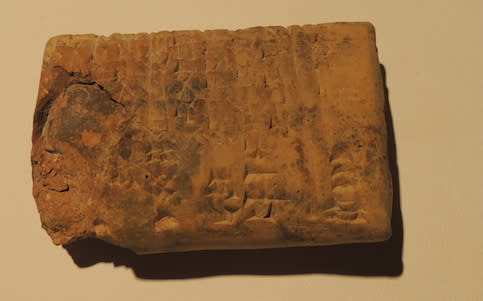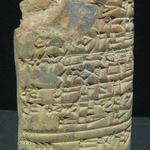Sumerian Cuneiform Tablet, 2032 BCE
Clay
1.8 x 2.9
LK.125
Further images
Sumerian cuneiform is one of the earliest known forms of written expression. First appearing in the 4th millennium BC in what is now Iraq, it was dubbed cuneiform (‘wedge-shaped’) because...
Sumerian cuneiform is one of the earliest known forms of written expression. First appearing in the 4th millennium BC in what is now Iraq, it was dubbed cuneiform (‘wedge-shaped’) because of the distinctive wedge form of the letters, created by pressing a reed stylus into wet clay. Early Sumerian writings were essentially pictograms, which became simplified in the early and mid 3rd millennium BC to a series of strokes, along with a commensurate reduction in the number of discrete signs used (from c.1500 to 600). The script system had a very long life and was used by the Sumerians as well as numerous later groups – notably the Assyrians, Elamites, Akkadians and Hittites – for around three thousand years. Certain signs and phonetic standards live on in modern languages of the Middle and Far East, but the writing system is essentially extinct. It was therefore cause for great excitement when the ‘code’ of ancient cuneiform was cracked by a group of English, French and German Assyriologists and philologists in the mid 19th century AD. This opened up a vital source of information about these ancient groups that could not have been obtained in any other way.
Cuneiform was used on monuments dedicated to heroic – and usually royal – individuals, but perhaps its most important function was that of record keeping. The palace-based society at Ur and other large urban centres was accompanied by a remarkably complex and multifaceted bureaucracy, which was run by professional administrators and a priestly class, all of whom were answerable to central court control. Most of what we know about the way the culture was run and administered comes from cuneiform tablets, which record the everyday running of the temple and palace complexes in minute detail, as in the present case. The Barakat Gallery has secured the services of Professor Lambert (University of Birmingham), a renowned expert in the decipherment and translation of cuneiform, to examine and process the information on these tablets. The following is a transcription of his analysis of this tablet:
‘The tablet is an administrative document from the period of the Third Dynasty of Ur, dated to the 6th year of Shu-Sin, fourth king of the dynasty, c. 2032 B.C. It is a record of three ox-herders in the government employ being struck off the list of such workers.
Translatio
[1……..]…..]…[…..] ox herder. 1. [………]
…….., son of a prostitue. 1. Buzalum, brother of Puzur-Kesh, house of the vizier. Not present: they have been deleted from the document, at the order of Ashgi-bani, administrator. Total: 3 men, ox-herders, not present. Reckoning of ox-herders, ………. ………… Ashgi-bani the administrator took (the tablet) Via Ur-Mes, governor. Month: the plow. Year Shu-Sin, king of Ur, erected a magnificent stele for Enlil and Ninlil.
The Sumerian scribes did not spare words. It was nothing unusual in a government bureaucracy of the Sumerians for a few men to disappear and be struck from the register. Legally they were not free to leave their employment, so some took the matter in their own hands and simply fled and tried to escape detection.
Cuneiform was used on monuments dedicated to heroic – and usually royal – individuals, but perhaps its most important function was that of record keeping. The palace-based society at Ur and other large urban centres was accompanied by a remarkably complex and multifaceted bureaucracy, which was run by professional administrators and a priestly class, all of whom were answerable to central court control. Most of what we know about the way the culture was run and administered comes from cuneiform tablets, which record the everyday running of the temple and palace complexes in minute detail, as in the present case. The Barakat Gallery has secured the services of Professor Lambert (University of Birmingham), a renowned expert in the decipherment and translation of cuneiform, to examine and process the information on these tablets. The following is a transcription of his analysis of this tablet:
‘The tablet is an administrative document from the period of the Third Dynasty of Ur, dated to the 6th year of Shu-Sin, fourth king of the dynasty, c. 2032 B.C. It is a record of three ox-herders in the government employ being struck off the list of such workers.
Translatio
[1……..]…..]…[…..] ox herder. 1. [………]
…….., son of a prostitue. 1. Buzalum, brother of Puzur-Kesh, house of the vizier. Not present: they have been deleted from the document, at the order of Ashgi-bani, administrator. Total: 3 men, ox-herders, not present. Reckoning of ox-herders, ………. ………… Ashgi-bani the administrator took (the tablet) Via Ur-Mes, governor. Month: the plow. Year Shu-Sin, king of Ur, erected a magnificent stele for Enlil and Ninlil.
The Sumerian scribes did not spare words. It was nothing unusual in a government bureaucracy of the Sumerians for a few men to disappear and be struck from the register. Legally they were not free to leave their employment, so some took the matter in their own hands and simply fled and tried to escape detection.





